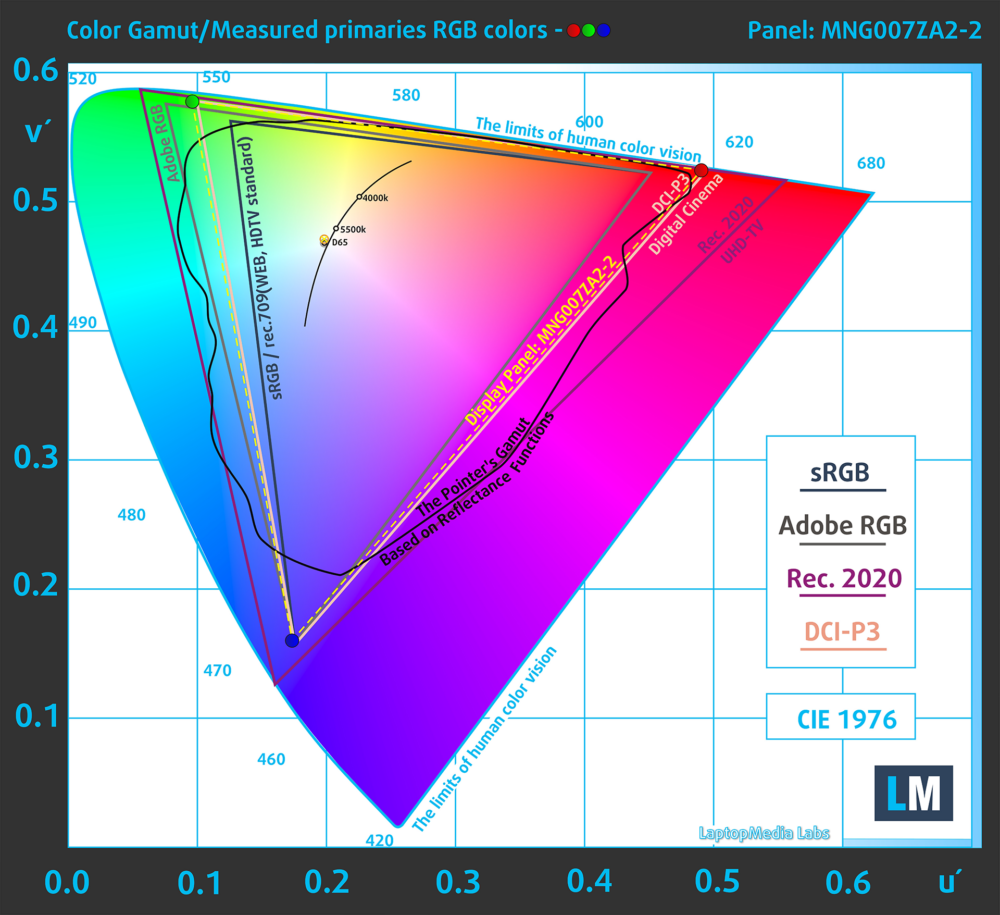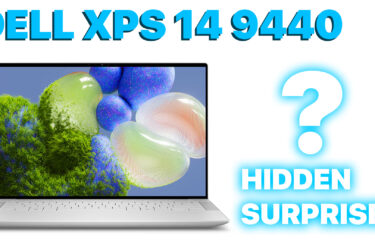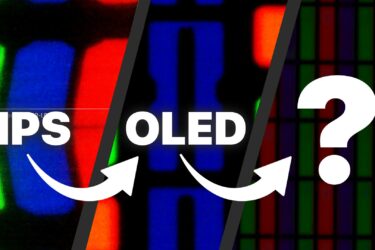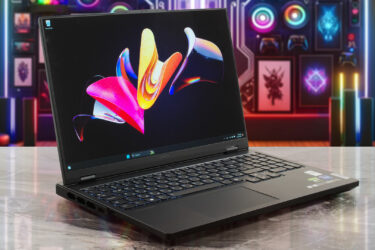Lenovo Legion 9i Gen 8 (16, Intel) review – hands down, so much power inside a thin chassis
Display quality, Health impact (PWM), Sound
Lenovo Legion 9i (16″, Gen 8) is equipped with a 3.2K Mini LED panel, model number CSOT MNG007ZA2-2 (CSO1629). It comes with a 165Hz refresh rate. Its diagonal is 16.0″ (40.6 cm), and the resolution – 3200 x 2000p. Additionally, the screen ratio is 16:10, the pixel density – 236 ppi, and their pitch – 0.11 x 0.11 mm. The screen can be considered Retina when viewed from at least 37 cm, which is excellent for a laptop (from this distance, the average human eye can’t see the individual pixels).
Viewing angles are good. We offer images at different angles to evaluate the quality.
Also, a video with locked focus and exposure.
The measured maximum brightness depends on the content of the picture. On a black background, white fill at 3% of the screen area, Brightness slider at 100%, the maximum brightness (Luminance) was 860 cd/m2 in the center of the screen (HDR Off). We measured a great contrast ratio – 16300:1 (ANSI Contrast).
To make sure we are on the same page, we would like to give you a little introduction to the sRGB color gamut and the Adobe RGB. To start, there’s the CIE 1976 Uniform Chromaticity Diagram that represents the visible specter of colors by the human eye, giving you a better perception of the color gamut coverage and the color accuracy.
Inside the black triangle, you will see the standard color gamut (sRGB) that is being used by millions of people on HDTV and on the web. As for the Adobe RGB, this is used in professional cameras, monitors, etc for printing. Basically, colors inside the black triangle are used by everyone and this is the essential part of the color quality and color accuracy of a mainstream notebook.
Still, we’ve included other color spaces like the famous DCI-P3 standard used by movie studios, as well as the digital UHD Rec.2020 standard. Rec.2020, however, is still a thing of the future and it’s difficult for today’s displays to cover that well. We’ve also included the so-called Michael Pointer gamut, or Pointer’s gamut, which represents the colors that naturally occur around us every day.
The yellow dotted line shows Lenovo Legion 9i (16″, Gen 8)’s color gamut coverage.
Its display covers 100% of the sRGB/ITU-R BT.709 (web/HDTV standard) in CIE1976, and 98% of DCI-P3, ensuring a super vibrant and attractive picture.
Our “Design and Gaming” profile delivers optimal color temperature (6500K) at 140 cd/m2 luminance and sRGB gamma mode.
We tested the accuracy of the display with 24 commonly used colors like light and dark human skin, blue sky, green grass, orange, etc. You can check out the results at factory condition and also, with the “Design and Gaming” profile.
Below you can compare the scores of the Lenovo Legion 9i (16″, Gen 8) with the default settings (left) compared to the DCI-P3 color space and with the “Gaming and Web design” profile (right). The default settings are very good.
Response time (Gaming capabilities)
We test the reaction time of the pixels with the usual “black-to-white” and “white-to-black” method from 10% to 90% and vice versa.
We recorded Fall Time + Rise Time = 2.9 ms. More importantly, the backlight has significant pulsations (more on the PWM graph below). There are gaming monitors that feature a deliberately pulsating backlight mode for a clear picture in dynamic scenes. In the current case, from a gaming perspective, things are great, but that’s not the best solution for your eyesight in the long run.
Health Impact: PWM (Screen flickering)
Pulse-width modulation (PWM) is an easy way to control monitor brightness. When you lower the brightness, the light intensity of the display is not lowered, but instead turned off and on by the electronics with a frequency indistinguishable to the human eye. In these light impulses, the light/no-light time ratio varies, while brightness remains unchanged, which is harmful to your eyes. You can read more about that in our dedicated article on PWM.
Lenovo Legion 9i (16″, Gen 8)’s backlight has significant pulsations. Their frequency is high, but the filling coefficient is very low. The last segment of the chart below is from another display, which has a similar maximum brightness but does not use PWM. This display might not be very comfortable for the more sensitive users.
Health Impact: Blue light emissions
Installing our Health-Guard profile not only eliminates PWM but also reduces the harmful Blue Light emissions while keeping the colors of the screen perceptually accurate. If you’re not familiar with the Blue light, the TL;DR version is – emissions that negatively affect your eyes, skin, and your whole body. You can find more information about that in our dedicated article on Blue Light.
Health Impact: Gloss-level measurement
Glossy-coated displays are sometimes inconvenient in high ambient light conditions. We show the level of reflection on the screen for the respective laptop when the display is turned off and the measurement angle is 60° (in this case, the result is 64.9 GU).
Sound
Lenovo Legion 9i (16″, Gen 8)’s speakers produce a sound of very good quality and high maximum volume. Its low, mid, and high tones are clear of deviations.
















